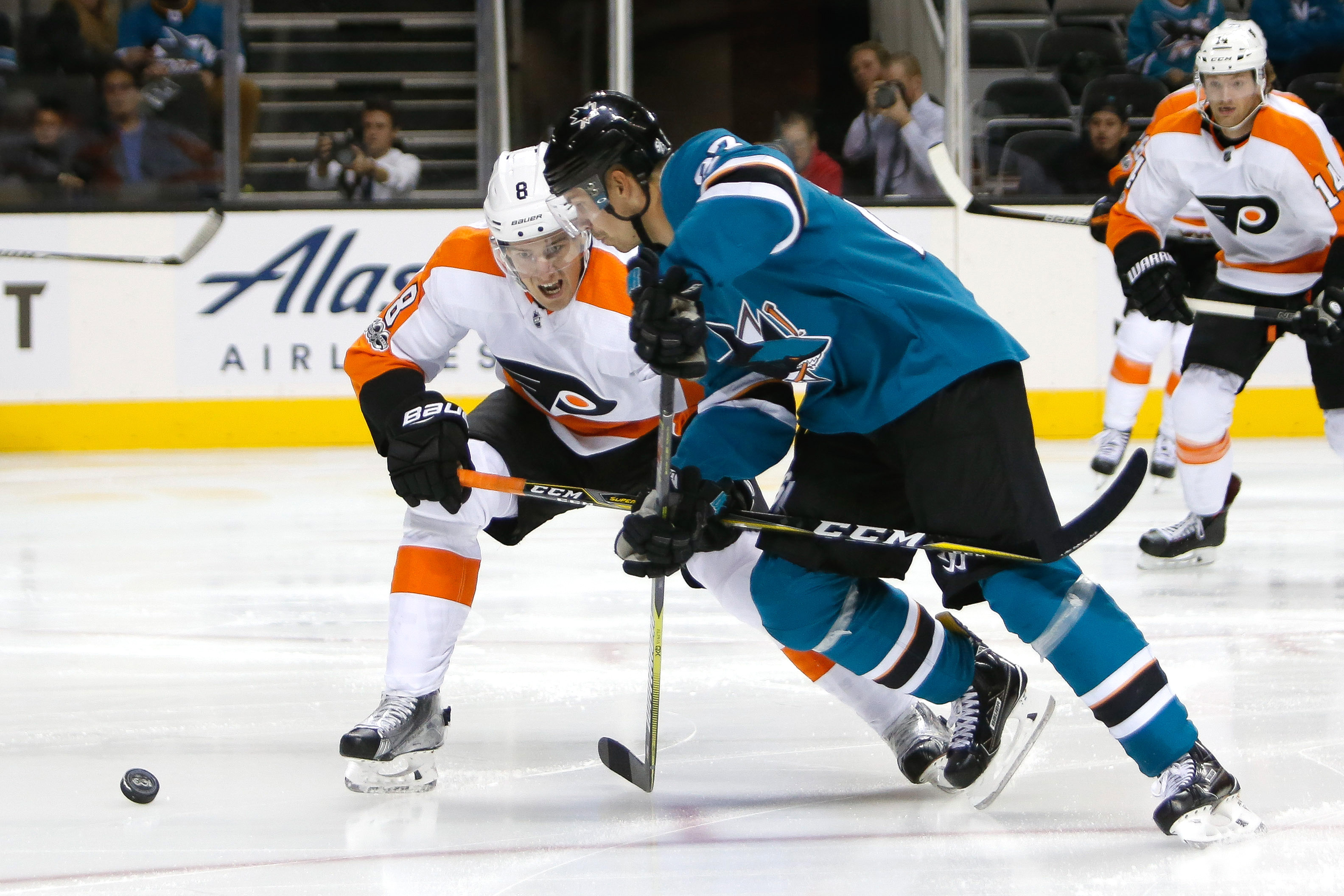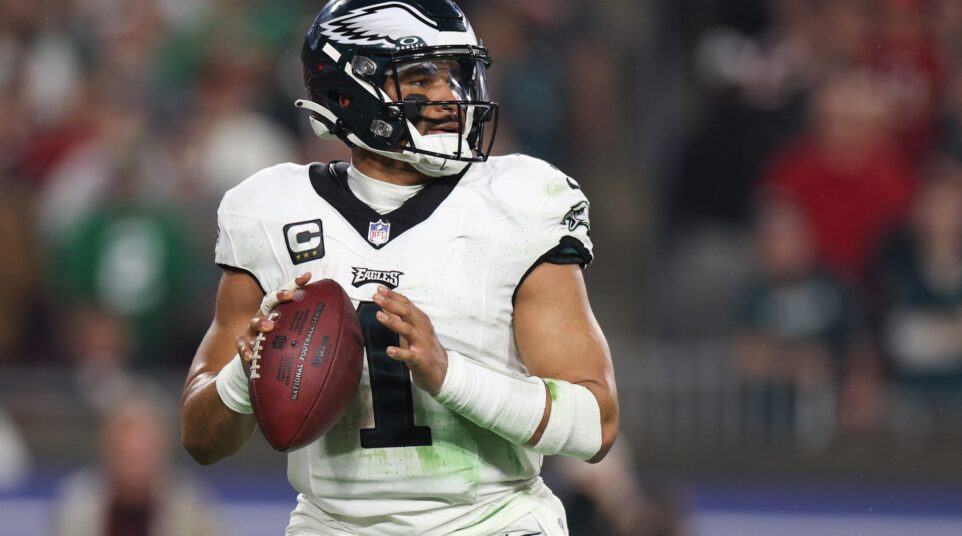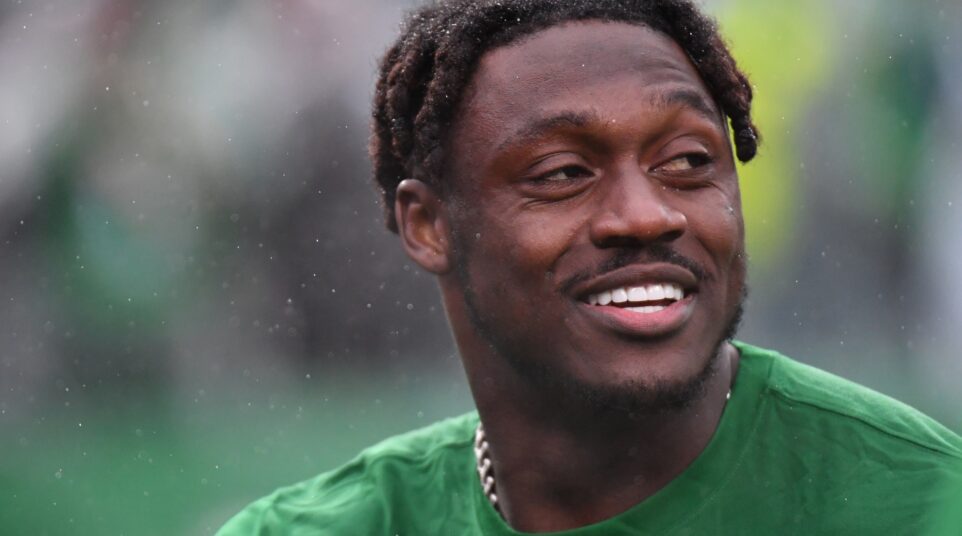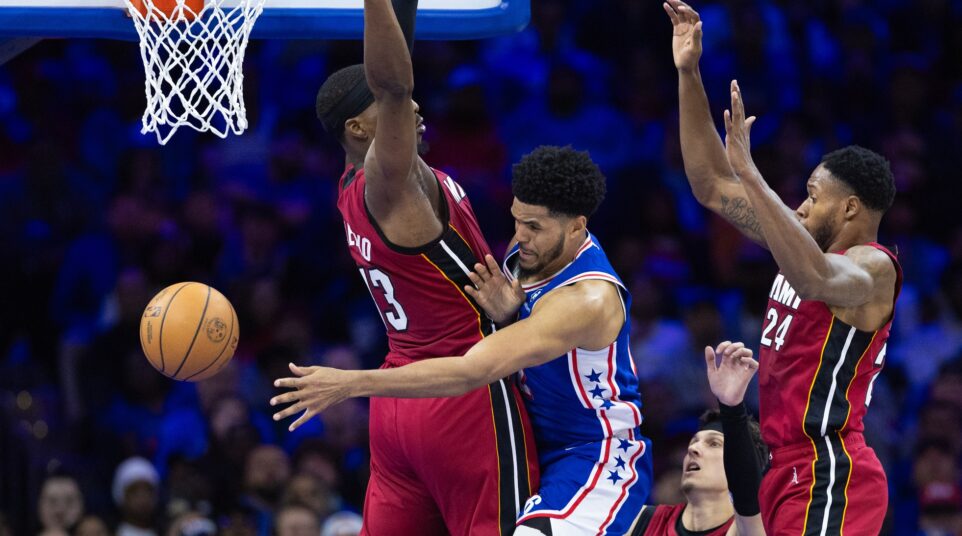
Behind The Beat: Robert Hagg Is Making Shayne Gostisbehere Better, and A Defense of Andrew MacDonald
Each week, Anthony will take you inside the locker room, press box or wherever else he finds himself, with anecdotes, observations, quotes and maybe the occasional barb that he sees or hears while covering the Flyers. I guess you could say, Anthony’s In The Room.
A hockey locker room is always a Petri dish of activity. Different personalities, different routines, and different conversations all collide in one confined space.
It was no different after Flyers practice Monday.
There was Jake Voracek, stroking his Yukon Cornelius beard while cracking up the pool of reporters and cameramen who surrounded his stall.
There was Dale Weiss and Claude Giroux, trying to answer a trivia question posed by Vice President of Public Relations, Zack Hill, about the only teenage hockey players to post 100-point seasons.
(The answer was five by the way – Wayne Gretzky and Mario Lemieux are the obvious ones, then there’s Sidney Crosby, Dale Hawerchuk and Jimmy Carson.)
There was Scott Laughton and Michael Raffl, with their traditional post-practice pow-wow in the far corner of the room, with Raffl proudly donning his Cleveland Indians baseball hat as he has every day since the beginning of training camp, even though they were eliminated from the playoffs a week ago.
And then there was Robert Hagg. Quiet. Unassuming. Slowly removing his equipment, occasionally looking up to take in the activity around him, but otherwise keeping to himself.
Just a moment earlier, his defensive partner, Shayne Gostisbehere, was holding court with the media. It started off as a conversation with Flyers radio play-by-play guy Tim Saunders and me, but soon he was surrounded by every microphone or camera in the room and being asked about his renewed confidence that has led to an eight-assist start to this season in just five games.
And although he did credit his partner (and we’ll get to that in a bit), no one seemed interested in talking to Hagg.
So I decided to stop him for a chat before he disappeared into the Skate Zone inner sanctum completely unnoticed.
What I found was a young athlete who is as relaxed and comfortable in his own skin off the ice as he is on it.
“It doesn’t really matter who you are on the ice,” Hagg said. “You want to be the same guy when you step off it. I want to be the same guy I was five years ago. It shouldn’t change just because you make it to the NHL. You have to be the same person. You can’t let this affect you.
“If you ask any of my friends, they’ll tell you I’m trying not to change at all and that I’m going to continue to be myself, no matter what.”
You may ask, what the hell does this have to do with hockey? I’m sure there are a lot of good guys who were never successful in the NHL.
And that point is quite valid. However, this is a guy with all of six career NHL games under his belt who is playing as sound a defensive game as you will see.
There’s nothing flashy about Hagg. Nothing that screams “Look at me.” And yet, he is quickly becoming one of the Flyers’ more reliable defensemen – and it’s this even-keeled approach to who he is as a person – not a hockey player – that has made the progression into the NHL so smooth for him.
“I guess that is part of it,” he said. “I never thought of it like that, but now that you ask, maybe that is. I just try to stay humble and treat every person the same way I would want them to treat me and I think you can go a long way with that approach.”
Off the ice, it makes him one of the good guys. On the ice, it garners respect. Sometimes, that’s a lost art in a sport like hockey. The game is so fast and so violent at times that players don’t take the time to work on the things that earn respect in the league.
Sure, superior talent alone can garner respect in-game – take Crosby for instance. He became such a hated figure in cities like Philadelphia partly because he is the best player in the sport and plays for the Flyers’ arch rival, but also in part because when he came into the league, he earned his respect through his talent, and not necessarily his personality.
Crosby was perceived as a whiner, a flopper, and, in turn, a dirty player.
There was one point in his rookie season where he and Flyers Center Peter Forsberg had a pretty big run in. Forsberg accused Crosby of diving. Crosby got mouthy. Forsberg told him to respect the game.
The way he plays the game now has certainly changed since he was a rookie in 2005, but that early career reputation followed him. A savvy veteran and a fierce competitor as the game’s best player, it’s hard for Crosby to not step on the ice in Philly, or Washington, or New York without hearing the catcalls.
It’s all because of how he approached the game as a rookie.
Now, Hagg is no Crosby. Not even close. But the difference in which they are viewed as rookies is also quite noticeable.
Hagg is even-keeled. Level-headed. He’s not chirping at officials. He’s not whining at players on the other team. He’s just here to play hockey, play it fairly and competitively, and then he’s going to go back being the same guy he’s always been.
And that guy is bringing out the best in Gostisbehere.
Sure, they’ve only played together for five games, but in those five games they are getting a lot of ice time – more than 20 minutes a game – and they are producing on both ends of the ice.
“He’s made my job a little easier,” Gostisbehere said. “He’s wiped my butt out there a couple times. He’s not a hard guy to play with. He’s so smooth and he’s sneaky strong down low.
“I’m definitely a risk taker out there sometimes and it’s nice to know that you’ve got a guy back there who will always help you if you get into trouble. He’s always calm, cool and collected. He’s a great partner.”
Again, it’s just five games, but this pairing is having an impact. It’s allowing Gostisbehere to play the way he did when he burst onto the scene two seasons ago.
And that bodes well for the Flyers.
In other news:
I got into it on Twitter with some fans the last two days about Andrew MacDonald. No, I don’t think he’s an All-Star. No, I’m, not clouded by his “good guy” status in the locker room. I have no agenda. I’m not covering the team to make friends.
But what I am doing is trying to correct a falsely-penned narrative – and that is that MacDonald is some hideous defenseman who is only playing because the Flyers want to justify his absurd contract.
A couple of things here:
- The contract is ridiculous and he is overpaid. That’s not his fault. Imagine being offered an obscene raise to do your job. You’d take it, right? Whether you are worth it or not, you’d take it. Don’t blame him, blame the team for giving it to him.
- He is not a hideous defenseman.
It’s that second point where the masses and I differ.
MacDonald is an NHL-quality defenseman. Hands down. He may not be a top pair guy – and he’s receiving top pair minutes with partner Ivan Provorov (who is healthy by the way, the limp scare from Saturday was quelled Monday), but again, is that his fault? Should that put him under the microscope more?
MacDonald is going out there and playing decent hockey. He has had a nice start to the season. That can’t be argued.
And yet, he is crucified for every negative thing that happens if he’s on the ice. Abused for it even. So much so he was booed by the hometown fans during introductions at the home opener.
It’s a ridiculous and uninformed fan obsession.
I know, I know, his advanced statistical numbers are not good – so let’s use that as a reason to crucify him.
Please.
It is that mentality that I pushed back against Saturday.
I tried to explain in No. 5 of my takeaways from the home opener that despite the massive Twitter criticism of MacDonald on the Capitals’ first goal, he wasn’t at fault and that either Giroux or Voracek should have been covering his spot as part of a rotational play since MacDonald was marking Alex Ovechkin.
I was in turn chided with tweets like this:
https://twitter.com/JasonAAV/status/919969101858172928
https://twitter.com/JasonAAV/status/919969188894167040
So that aforementioned writer that Jason only reads, Charlie O’Connor, who covers the team for The Athletic Philly and does a really nice job breaking down games with advanced statistics, followed up with coach Dave Hakstol after practice Monday. Here’s how it went:
O’Connor: Question regarding the first goal by Washington on Saturday – there’s a turnover along the boards, Ovechkin gets the puck, Mac challenges him up high. Does he have the green light to challenge him up high and a forward has to cycle back down to prevent a 2-on-1 down low, or should the defenseman stay further down and not challenge directly Ovechkin in that case?
Hakstol: Both of our defensemen did exactly what they should do on that play, we missed the coverage with the low forward.
So, let’s see, MacDonald does exactly what he’s supposed to do, a forward doesn’t do his job (as I pointed out Saturday – it was either Voracek or Giroux as they were both on that side), the Capitals score, and in turn MacDonald’s advanced statistics take a hit.
So – he must be terrible, right?
https://twitter.com/CFJastrzembski/status/919346778448777217
This isn’t an argument about the eye test vs. advanced statistics. This isn’t some witch hunt to make the Flyers’ best players look bad like others suggest.
All this is on my part, is providing an understanding of hockey systems and how they work and affect everyone on the ice. I used to have coaches take me into their office and sit me down and show video and explain to me how the systems work and what I should be looking for when covering the game so as to report it properly.
I did this with Ken Hitchcock, John Stevens and Craig Berube. I haven’t done it with Hakstol, and I don’t know if I ever will. Having not been on the beat with any regularity since the guy’s been coach until now, I haven’t had that opportunity to get to know him well enough, but I’ll try.
The point is, I’m never going to try to pass off information as part of an agenda. I’m going to give it to you straight and fairly and with an educated view – in other words, using my access for your benefit, not my own.
Analytics in hockey are a useful tool. But some people read them as gospel, and that’s just wrong. They definitely serve a purpose. They finally bring an ability to quantify actions in hockey that have been taking place since the dawn of the sport.
I’ll take you back to that first video session with Hitchcock.
I sat in his office for an hour watching tape with him. At one point, he said, “Anth, Here’s what you need to understand. The game is the puck. You can’t win unless you have the puck in your possession. The more you possess the puck, the more chances you have, the better your odds are of winning the game.”
This, friends, was in 2003. Sure sounds a hell of a lot like Corsi, doesn’t it?
We may not have had the statistical measurement of it yet, but it was definitely how coaches viewed the sport and coached it with puck possession in mind.
All that said, yes, MacDonald will make mistakes – and when he does, I’ll point them out. But, I’m just as quickly going to point them out if its Giroux, Voracek, Provorov, Sanheim, Hakstol – I’m an equal opportunity analyst!
I just want to offer you perspective – and although I’ll never connect with everyone, I hope it’s illuminating for at least some of you.





